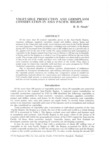Vegetable Production and Germplasm Conservation in Asia-Pacific Region
Tropical agriculture research series : proceedings of a symposium on tropical agriculture researches
| ISSN | 03889386 |
|---|---|
| 書誌レコードID(総合目録DB) | AA00870529 |

本文フルテキスト
tars23-_78-92.pdf3.38 MB
Of the more than 30 tropical vegetables grown in the Asia-Pacific Region, tomatoes, cabbages, eggplant, cucumber, pepper and chillies, onions, beans and potatoes in the Asian part and aroids, sweet potatoes and yams in the Pacific Islands are more important. Vegetable production, excluding roots and tubers, in the Region during 1977-87 increased from 154 million tons to 207 million tons at a growth rate of 3%, against 2.1% in the rest of the world. Per caput production and consumption of vegetables in the Region ranged from 8 kg/year in Bhutan to 225 kg/year in Republic of Korea and for the Region as a whole it was 72 kg against 126 kg for the rest of the world. The average yield of most vegetables in the Region was about half to one-third of that in the rest of the world, and there were wide inter-country yield differences, some countries recording yields as high as anywhere in the world. Thus, there is ample scope for improving vegetable yield and there are great prospects for TCDC (technical cooperation among developing countries).
Due to increased adoption of uniform varieties, displacement of indigenous vegetables by European introductions, and shifting cultivation in several countries, the vegetable genetic resources are eroding fast. Cooperative action is needed for strengthening national efforts for conservation and utilization of genetic resources. FAO attaches high priority to improved production and conservation of vegetables and has several on-going projects at national and regional levels.
Due to increased adoption of uniform varieties, displacement of indigenous vegetables by European introductions, and shifting cultivation in several countries, the vegetable genetic resources are eroding fast. Cooperative action is needed for strengthening national efforts for conservation and utilization of genetic resources. FAO attaches high priority to improved production and conservation of vegetables and has several on-going projects at national and regional levels.
| 刊行年月日 | |
|---|---|
| 作成者 | R. B. Singh |
| 公開者 | Japan International Research Center for Agricultural Sciences |
| 巻 | 23 |
| 開始ページ | 78 |
| 終了ページ | 92 |
| 言語 | eng |
